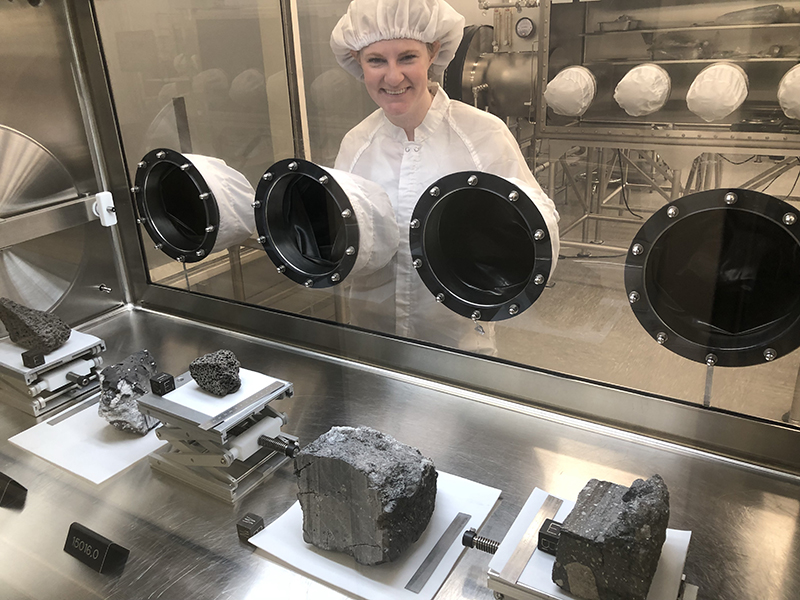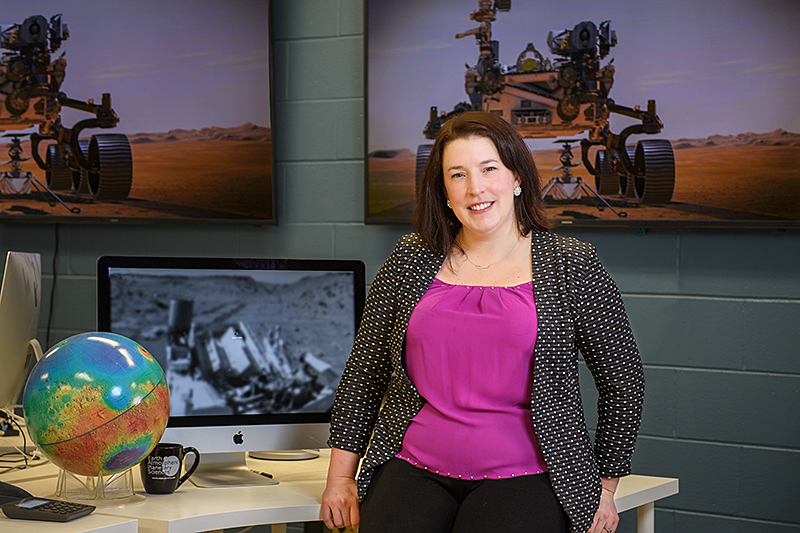Purdue scientists and engineers push the boundaries of space … – Purdue University
Brandon Johnson, an expert in impact crater dynamics, is surrounded by some of his favorite research subjects: Mercury, Mars and the moon. (Purdue University photo/Rebecca McElhoe)
WEST LAFAYETTE, Ind. – Scientists and engineers at Purdue University focus on a future in the stars, with research stretching from what moondust can tell us about the history of the solar system to future exploration priorities on Mars and beyond.
Research at Purdue is involved in the latest discoveries by NASA’s Perseverance rover mission and can offer insight into the initial and future Artemis missions.
A sampling of Purdue’s inspiring and innovative research in space and planetary science, highlighting Purdue’s leadership, expertise and innovation, is below. If you have any questions or would like to speak to a university expert, contact Brittany Steff, bsteff@purdue.edu; Kayla Wiles, wiles5@purdue.edu; or Brian Huchel, bhuchel@purdue.edu.
 Michelle Thompson is one of the new generation of scientists working on the Apollo moon missions. (Photo provided) Download image
Michelle Thompson is one of the new generation of scientists working on the Apollo moon missions. (Photo provided) Download imagePurdue students in persistent pursuit of new heights with rocket research
Boilermakers never stop in their pursuit to become the best, even if that means launching a rocket in a remote corner of the Mojave Desert twice in one weekend – a first for a collegiate team.
The journey into the cosmos always begins at home, and that’s where much of space research begins, too.
Modeling explosions to plumb the secrets of the solar system
Planetary scientist Brandon Johnson’s feet are firmly on the ground, though he uses data from satellites and space missions to study and map planetary bodies in the solar system.
- Studying how impacts affect planetary bodies, asteroids, moons and other rocks in space helps planetary scientists understand extraplanetary geology, especially where to look for precious matter including water, ice and even life. A YouTube video is available online.
- Past impacts, on Earth and on other planets, can help explain the history of the solar system.
- Johnson’s research increases understanding of past and potential asteroid impacts on Earth, for example the huge global tsunami that followed the dinosaur-killing asteroid impact.
How airless planetary bodies interact with space gives insight into ancient planetary histories
Planetary geologist Michelle Thompson studies space weathering, the effect of exposure to space on asteroids and bodies lacking atmospheres, like our own moon.
- Thompson studies samples from the original Apollo missions, collected before she was born, to understand the nature of moondust.
- The samples brought back by the Hayabusa2 mission, the first asteroid samples ever collected in space and brought back, give insight into conditions on early Earth that may have helped lead to life.
- She is on the tiger team for OSIRIS-REx and will be the first woman to study samples from the asteroid Bennu.
 Briony Horgan, associate professor of planetary science, sits inside the Mars Rover Operations Center in Purdue’s Delon and Elizabeth Hampton Hall of Civil Engineering. Horgan is part of the Mars rover mission. (Purdue University photo/Rebecca McElhoe) Download image
Briony Horgan, associate professor of planetary science, sits inside the Mars Rover Operations Center in Purdue’s Delon and Elizabeth Hampton Hall of Civil Engineering. Horgan is part of the Mars rover mission. (Purdue University photo/Rebecca McElhoe) Download imageRover Perseverance using unprecedented equipment to illuminate the history of the red planet
- Briony Horgan, associate professor of planetary science, led the efforts to designate Jezero Crater for the rover’s landing and now is a long-term planner as part of the science leadership for NASA’s rover. Year 2 research is well underway.
- “Mars was a much more Earth-like place” billions of years ago: Horgan talks about the extreme changes at Jezero Crater, from a large delta and lake area to a dried-up surface where lava once flowed. (YouTube)
- Horgan reflects on the mission’s first year and talks about work in 2022 focused on the delta of Jezero Crater and the search for microbial life that may have lived at the bottom of the ancient lake. (YouTube)
- Roger Wiens, a Purdue scientist formerly of NASA’s Jet Propulsion Laboratory, leads the team that controls Perseverance’s SuperCam suite of tools and instruments, giving the rover four of the five human senses. The team has made a series of astonishing discoveries and “firsts,” including capturing the first-ever sound recording of a dust devil on Mars, finding olivine in the sands of Jezero Crater, and engraving the first letter on the Martian surface to study Mars’ magnetic field.
Purdue space research and expertise in the news
Divide and conquer: Mars rovers to be superseded by swarms of two-wheeled robots
Mars Daily
In its visit to Psyche, NASA hopes to glimpse the center of the Earth
Popular Science
New clues reveal the devastation the day the dinosaurs died
National Geographic Magazine
NASA’s Perseverance Rover Is Hunting for Ancient Life
Popular Mechanics
A year after landing on Mars, Perseverance rover sets sights on intriguing new target
CNN
NASA’s Perseverance rover prepares for its longest Mars drive yet
Axios
Purdue alumni legacy in space
This Is Purdue Ep. 62: Purdue Alum Ronak Dave’s Next Giant Leap: NASA Flight Director
The Persistent Pursuit: Audrey Powers ‘overwhelmed’ to join Purdue’s Cradle of Astronauts
This Is Purdue Ep. 48: NASA Space Suit Engineer Amy Ross Discusses Purdue’s Impact on Her Career
About Purdue University
Purdue University is a top public research institution developing practical solutions to today’s toughest challenges. Ranked in each of the last five years as one of the 10 Most Innovative universities in the United States by U.S. News & World Report, Purdue delivers world-changing research and out-of-this-world discovery. Committed to hands-on and online, real-world learning, Purdue offers a transformative education to all. Committed to affordability and accessibility, Purdue has frozen tuition and most fees at 2012-13 levels, enabling more students than ever to graduate debt-free. See how Purdue never stops in the persistent pursuit of the next giant leap at https://stories.purdue.edu.






